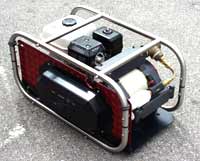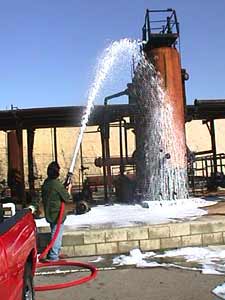| Fire’s
New Foe
CFX offers all the benefits
of halon, without the danger of personal injury
By Cam Benty
4/11/05
Face it, halon is bad for drivers and racecars.
But fire is worse, and up until now there has been little
choice in the matter. To save lives, halon is the answer.
 But
CFX (Compressed air foam) offers a unique chance to change
all that. With a new delivery system created by EP Industries
in El Segundo, CA (www.epindustries.com)
CFX offers all the benefits of halon but without the damaging
effects. But
CFX (Compressed air foam) offers a unique chance to change
all that. With a new delivery system created by EP Industries
in El Segundo, CA (www.epindustries.com)
CFX offers all the benefits of halon but without the damaging
effects.
“I could literally foam an entire car with CFX and
never hurt the vehicle,” says CFX system builder Eddie
Paul. “It would be just like a giant engine degreaser.
Once the foam evaporates, there is no affect on the vehicle.
Best of all it is completely non-toxic to the driver of the
car.”
 The
CFX delivery system, designed by EP Industries, involves a
high volume pump patented by Paul that delivers the compressed
air foam solution through a fire hose. Both small freestanding
portable units and larger truck mounted systems are available.
The result is instant delivery to the source of the fire. The
CFX delivery system, designed by EP Industries, involves a
high volume pump patented by Paul that delivers the compressed
air foam solution through a fire hose. Both small freestanding
portable units and larger truck mounted systems are available.
The result is instant delivery to the source of the fire.
“We have been building pumps for the forest service
and other private fire departments for the past 12 years,”
says Paul. “Our individual pump system is one tenth
the weight of competing conventional systems and are completely
portable, incorporating a small gasoline engine or r 12 volt
DC motor that allows it to be carried right to the source
of the fire.”
Part of the beauty of the system is also the limited amount
of actual water required to make it work. With five gallons
of water, the EP Industries CFX unit can generated more than
100 gallons of compressed air foam retardant, far more than
required to put out any fire. Best of all, it works on any
kind of fire including methanol, jet fuel and nitro methane.
In US government testing conducted in Washington, D.C., the
CFX system exceeded every challenge and regulation for fire
system compliance.
“The foam is extremely versatile. We have yet to find
a fire that we can’t put out as quickly [and generally
faster] than any other type currently approved fire extinguishing
system,” says Paul. “The hardest part is getting
the public and other agencies to realize we have a system
that works as well or better than what they have currently,
plus the added benefits of not harming racecars or their occupants
and costing the same or less than what they have right now.
With so many positives, it is hard for many people to believe
the story behind CFX.”
With 12 years of CFX experience, Paul has been working on
developing an in-car CFX system that would extinguish racecar
fires. The system would incorporate an EP Industries pump
that is triggered by a self-contained battery driven system
to deliver the foam. The completely non-toxic nature of the
foam would extinguish the fire like halon with no ill effects
to the driver.
“I have created a similar system for the marine industry
where fire safety has always been an issue,” says Paul.
“Because of the corrosive nature of the marine environment,
pressurized fire extinguishers are dangerous, but up until
now there has not been an alternative. My self-contained extinguisher
is not pressurized until you open the nozzle. Then it works
like a conventional extinguisher except that it last six minutes
rather than the 20 seconds you get from a regular extinguisher.
Plus the bottle is made from plastic which is safer and lighter
than aluminum or steel units.”
Plus it's safe for marine life – What a bonus.
|

